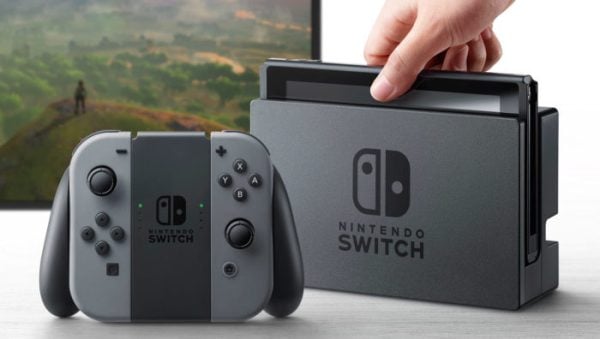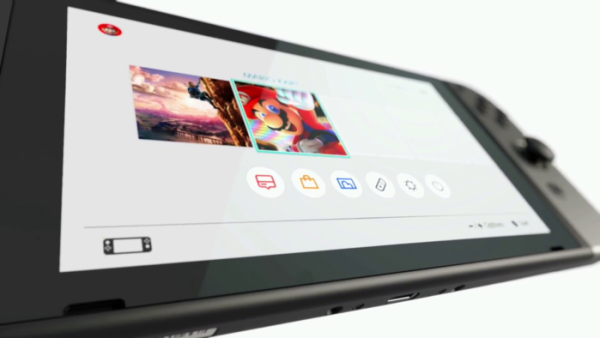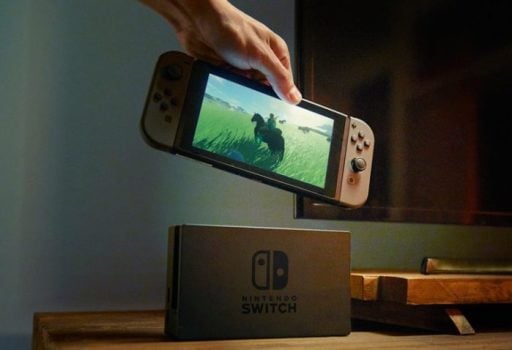The Hardware is Awesome

First and foremost, the Switch is a gorgeous and exciting piece of kit. Forget the Fisher Price feel of the Wii U gamepad with its loose rickety buttons and budget-looking screen, the Switch feels like a quality engineered product. It has a sleek, mature aesthetic to its design, much more closely aligned to modern tablets than the plastic-fest of the Wii and Wii U. Its thumb sticks feel nice and tight, the unit has a good weight to it, and the Joy-Con controllers slide in and out with a satisfying click. The screen itself is of a far higher quality than what we’ve seen from Nintendo in the past. It still isn’t glass, but it’s much better than the Wii U and the 3DS, with colors that are well calibrated, making games appear vibrant and bright.
Even the color of the Switch is all grown-up if you want it to be. Muted in dark gray and black, it looks right at home next to your iPhone or Android device, appropriate enough for suited business on the commute home as it is younger audiences. But there’s still that Nintendo charm factor if that’s more your thing thanks to the colored Joy-Con option. Blue and Red Joy-Cons have since been joined by Splatoon-themed options, and there are other colors available if you want to import from Japan.
Of course, the Joy-Cons can be played attached or detached from the console, which takes advantage of the motion controls and HD rumble features. It’s neat that the Switch lets you play to your preference or mix things up depending on which game you’re playing. Speaking of which, thanks to the flash memory card setup, at last, a Nintendo console has the capability to store plenty of different games, even if it isn’t proprietary.
The User Interface is Much Improved

Before Nintendo patched the Wii U to improve its performance, the console was desperately slow, and it was actually only marginally improved later. Not to mention, the emphasis on dual screen functionality shaped the whole experience into a confusing juggle between the TV and the gamepad. Rejoice, all of this is gone with the Switch, as Nintendo’s console swaps sluggish and convoluted menus for a simplistic UI that is both lightning quick and refreshingly minimalist in design.
Perhaps taking a hint from successful interfaces seen on iOS and Android devices, the Switch’s menus are obvious and intuitive. Not only that, the console snaps to life from sleep in milliseconds, even if a game is still booted. Other features like taking screenshots and uploading them to social media accounts is also super zippy. The Switch might not be the most powerful hardware, but in practice, it feels quicker and more advanced than rival consoles. The Switch also uses a whole bunch of adorable noises typical of a Nintendo product — hardly of vital importance but there’s a charm factor that makes it that extra bit more exciting to pick up and use.
Exceptional Year-One Games Lineup Continues to Build Momentum

After Nintendo’s painfully slow output of games during the Wii U era, and then the concerning lack of third-party support evident at its big reveal in January this year, a lack of software was a major concern with the Switch. But our trepidation was misplaced; the Switch is so far enjoying what is arguably one of the best first years of any console. Even on its own, The Legend of Zelda: Breath of the Wild technically makes it the best launch lineup of all time, but beyond that, the Switch is already supported by standout titles from first and third-party studios, as well as a smorgasbord of “Nindies” (indie games).
Just six months into the console’s first year and there’s already a critically acclaimed game across multiple genres. Open world adventure, competitive shooter, fighting game, racing game, strategy game — the Switch has covered nearly every base with several quality titles in record short time. In between, gamers are enjoying a continued stream of smaller indie games hitting the eShop every month. With the sales of Switch continuing to boom, we’re only going to see more ports make their way to the console, too.
Perhaps most importantly, there’s a real sense that Nintendo is committed to pulling out the stops and building a solid library for the Switch. One that not only draws on its iconic franchises but curates new IPs and revives fan-favorites. With 3DS support winding down and an overwhelmingly positive reception to Switch, Nintendo seems invested in continuing to churn out games for the console. Even looking past the rest of 2017, which is tantalizingly adorned with upcoming titles like Super Mario Odyssey and Xenoblade Chronicles 2, there are yet more reasons to be excited further out. At E3, Nintendo did something it normally never does: roadmap future content and announce games that fans have desperately asked for. A new Metroid Prime game in the works? Check. A mainline Pokemon RPG for Switch? Check. Based on that, there’s every reason to believe that the Nintendo Switch is going to enjoy plenty of support moving forward.
Hybrid Gaming is Magic

Playing a large-scale open-world game like The Legend of Zelda: Breath of the Wild in docked mode, then seamlessly switching to portable gameplay is a magical experience that is oh-so brilliant. It’s a concept that would have been impossible to conceive a decade ago, and even harder to imagine after the Wii U’s half-baked design almost realized the same vision years earlier, but the Switch is a true hybrid. Unlike the Wii U, which often required you to use the gamepad to access some of its features and play a select portion of its library, the Switch can be used entirely as a home console. Conversely, it can literally never be plugged into the dock and used exclusively as a handheld. While the battery life might not match dedicated handheld consoles such as the 3DS or PS Vita, it’s still good for four or five-hour sessions — longer if you want to purchase a third-party battery pack to extend its life.
The appeal of this hybrid design is hard to really appreciate until you’ve experienced it yourself. Portability suddenly adds a new dimension to old games without anything new being added to their design other than being ported to the system. And there’s no dilemma of choice between experiencing a game on the big screen or on-the-go as there is with consoles of the same family like Sony’s PS4 and PS Vita. Add to that the options that Switch’s portability bring to multiplayer, whether it be split-screen single console local multiplayer or linking multiple Switches together in a network, and its hybrid design offers unrivaled all-in-one versatility.
It’s a Social Experience

Without sounding too much like we’re echoing marketing jargon, the Switch’s hybrid design gives it the potential to offer multiplayer experiences that other platforms can’t match. Sure, the online infrastructure isn’t yet as solid as networks such as Xbox Live and PSN, nor is Switch’s strange voice chat via mobile phone application as modern as it should be, but the console’s design facilitates gameplay experiences you can’t have elsewhere.
For starters, the Switch offers competitive PvP multiplayer on-the-go with games such as Splatoon 2. While you could argue that the PS Vita was doing already doing this years ago with games like Killzone Mercenary, Switch’s better specifications, bigger player base, and the option to use a pro controller make it a complete experience.
Beyond the extra dimension that it brings to online multiplayer, there’s the novelty of its detachable Joy-Con controllers. Yes, they are a little small and somewhat awkward to use for people with larger hands, but this flexibility in design means the Switch can be carried around and used as a centerpiece in social gatherings, playing party games like 1 2 Switch. Or you can use them to share gaming experiences with a single friend, propping the Switch on its back stand and playing games of Mario Kart or Street Fighter II Ultra.
Handheld consoles have been a traditionally individual, somewhat anti-social gaming platform — the go-to personal device to combat boring car journeys or tedious waiting at airport terminals. But Switch’s accomplished online connectivity and the versatility of its hardware design challenges that stigma and gives players the options to share the gaming experience. Without analog controllers, that is a functionality even tablets can’t compete with.
